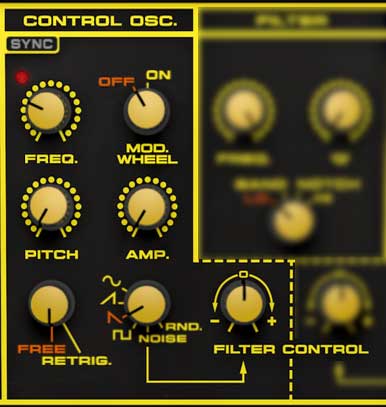
The Control Oscillator aka low-frequency oscillator generates sub-audio range signals intended for modulation purposes.
Freq.- The Freq. knob sets the modulation speed, from 0.10 to a rather brisk 100 Hz (with Sync button off) or from 8 beats up to 1/64th note triplets (Sync button on). The lamp above the Freq. knob flashes at the current modulation rate.
Sync- When the Sync switch is enabled, speed will lock to host tempo when using Yellowjacket within DAW software, or to the current tempo in the top menu bar when using the standalone version.
Mod Wheel- This is a handy, but potentially confusing feature, so don’t skim this section. If the knob is in the Off position, modulation is always “on.” Its effects will be immediately audible by moving the Pitch, Amp., and Filter knobs.
Selecting the On position enables control of mod depth with an external keyboard controller mod wheel. If the mod wheel is all the way down, mod depth is zero. This makes setting up a mod wheel to add vibrato or wah effects really easy. If it seems like the Control Osc. isn't working, check if the Mod Wheel control is set to On position.
Pitch- Applies modulation equally to both oscillators. Useful for vibrato, sirens, and all manner of racket with random mod wave and extreme mod amounts and rates.
Amp.- Applies modulation to the voltage-controlled amplifier (VCA). Subtle amounts are useful for tremolo effects; large amounts + fast mod frequency rates result in wild amplitude mod effects.
Free/Retrigger- In Free mode, the Control Osc. runs continuously. When set to Retrig., the modulation cycle resets monophonically when keys are struck. In other words - if no keys are down and a key is struck, the mod cycle resets on keydown. The mod cycle does not reset if additional keys are pressed, it only resets when all keys are released (trust us, if it reset with every keydown when playing polyphonically, the result tends to be rhythmically messy). Generally speaking, Retrig. is useful with ramp, saw, and square waves in combination with the Sync button.
Waveform- Selects sine, ramp, sawtooth, square, noise, or random (aka, sample and hold) modulation waves. Unlike many synths, all mod waves are bipolar like the original instrument. In the case of sine (or triangle) waves, this is desirable, so that pitch (i.e. vibrato) goes up and down evenly. However, with other shapes, particularly square waves, unipolar mod is usually more desirable so that the frequency remains constant when the mod wave is low, and increases as mod is increased when the wave is high.
Filter Control- Applies modulation to the Filter cutoff frequency. Center position is off; turn the knob counterclockwise for negative modulation, or clockwise for positive modulation. Note that Control Osc. modulation is additive, so mod may not be audible dependent on the current Freq. and filter mode settings.
(For example, if the Filter Freq. knob is all the way up, positive filter modulation will not be audible, because like Nigel Tufnel's amplifier top, if everything's on 10, where can you go? Nowhere. And unfortunately, Yellowjacket's controls do not go to 11.)